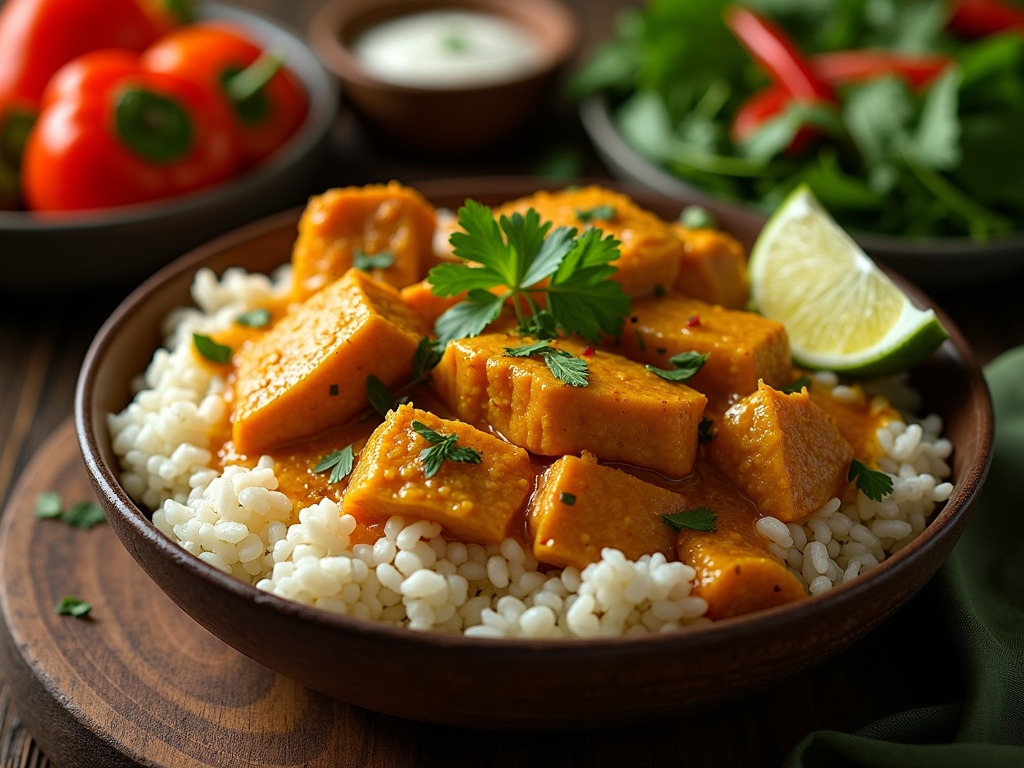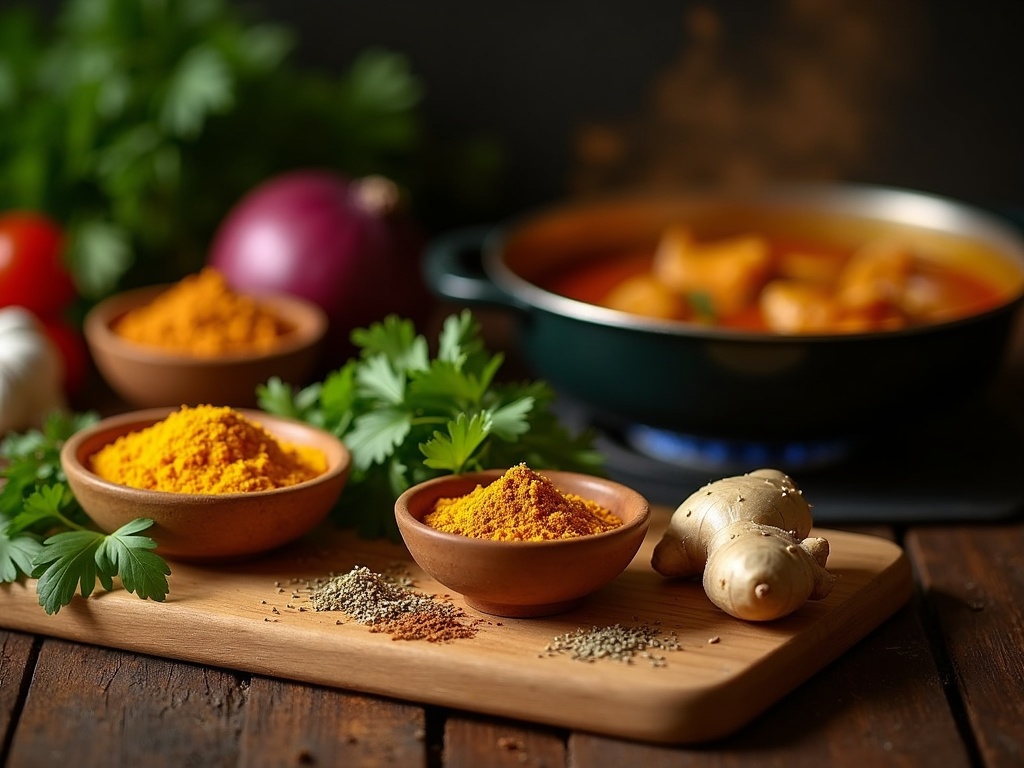Fish curry represents a global culinary treasure with incredible variations across different regions, each version highlighting unique flavor profiles created by local ingredients and cooking traditions. From the mustard oil-based curries of coastal India to the coconut milk-enriched Thai versions and the allspice-infused Caribbean interpretations, this versatile dish has captured the hearts of food enthusiasts worldwide while delivering impressive nutritional benefits.
Find In This Article
Key Takeaways
- Regional diversity creates distinct fish curry varieties, including Bengali (mustard paste), Goan (tamarind), Kerala (coconut milk), and Andhra (fiery chilies).
- Fish curry delivers nutritional benefits with 22-25 grams of protein per serving, omega-3 fatty acids, and essential nutrients like vitamin D, iodine, and B vitamins.
- The aromatic spice blend featuring turmeric, coriander seeds, cumin, ginger, and curry leaves creates the distinctive flavor profile of fish curry.
- Cooking techniques are crucial with fish requiring just 10-20 minutes of gentle simmering to achieve optimal tenderness without becoming tough.
- Different fish varieties offer unique textures and flavors, with salmon providing richness, cod offering firmness, and tilapia serving as a mild option for beginners.
A Worldwide Culinary Treasure: Regional Fish Curry Variations
Fish curry has captured the hearts and palates of food lovers across the globe. I’ve found that each region adds its own unique twist to this delicious dish, creating distinct flavor profiles that reflect local ingredients and culinary traditions.
Indian Fish Curry Traditions
In India, fish curry is a staple in coastal regions where fresh catches are abundant. The preparation often begins with mustard oil, which gives the curry its distinctive pungent aroma and flavor. Garam masala, a blend of warming spices including cardamom, cinnamon, and cloves, forms the backbone of many Indian fish curries.
What makes Indian fish curry special is the regional diversity:
- Bengali fish curry features mustard paste and green chilies
- Goan fish curry incorporates tamarind for tanginess
- Kerala fish curry uses coconut milk and curry leaves
- Andhra fish curry is known for its fiery heat from red chilies
Mackerel is particularly popular in Indian curries, especially along the western coast. According to global fish market data, mackerel is the most commonly used fish in Asian curries, valued for its rich flavor and firm texture that holds up well to spices.
Thai and Caribbean Interpretations
Thai fish curry takes a different approach, relying on curry pastes that blend lemongrass, galangal, and kaffir lime leaves. Coconut milk creates a silky, luxurious base that balances the heat from chilies. I’ve discovered that Thai curries tend to be lighter and more aromatic than their Indian counterparts, often incorporating fresh herbs like Thai basil and cilantro.
Caribbean fish curry reflects the region’s multicultural influences, blending African, Indian, and indigenous cooking techniques. What sets these curries apart is the use of allspice and scotch bonnet peppers, creating a distinctively tropical flavor profile. Caribbean cooks often add root vegetables like yams or sweet potatoes to create hearty one-pot meals.
The popularity of fish curry reflects broader trends in seafood consumption. The global fish market reached $262 billion in 2020, with projections showing a compound annual growth rate of 3.5% from 2021-2028. This growth speaks to increasing recognition of fish as both delicious and nutritious.
For those looking to explore the world of fish curries, I recommend starting with a fish stew that incorporates curry elements, then moving on to more complex recipes like sweet and sour fish with curry spices. For a heartier option, a fish pie recipe can be modified with curry flavors for a fusion approach.

Power-Packed Nutrition in Every Bowl
Fish curry isn’t just a flavor explosion—it’s a nutritional powerhouse that deserves a spot in your regular meal rotation. I’ve found that beyond its aromatic spices and rich sauce, this dish delivers impressive health benefits that support overall wellbeing.
Impressive Nutritional Profile
A typical serving of fish curry provides approximately 22-25 grams of protein per 3.5 oz serving, making it an excellent option for muscle maintenance and growth. Fish is considered a complete protein source, meaning it contains all nine essential amino acids your body can’t produce on its own. This makes fish curry particularly valuable for anyone looking to increase their protein intake without relying solely on meat.
What sets fish curry apart from many other protein-rich dishes is its impressive omega-3 fatty acid content. With approximately 2-3 grams of omega-3 fatty acids per serving, fish curry delivers these essential fats that support numerous bodily functions. These healthy fats are known to reduce inflammation, support brain health, and contribute to better vision.
The coconut milk commonly used in fish curry recipes adds another layer of nutritional benefits. Though relatively high in calories (about 600 calories per cup), coconut milk contains medium-chain triglycerides (MCTs) that the body can use for quick energy. I’ve noticed these healthy fats also create the satisfying richness that makes fish stew and curry dishes so comforting and filling.
Fish curry’s nutritional value extends beyond just protein and healthy fats. This dish is packed with essential nutrients including:
- Vitamin D, crucial for bone health and immune function
- Iodine, important for thyroid health
- Selenium, a powerful antioxidant
- B vitamins, essential for energy production
- Zinc, which supports immune function
The combination of fish with various spices like turmeric, cumin, and coriander adds anti-inflammatory compounds that may provide additional health benefits. I’ve incorporated these spices into fish pie recipes as well, but curry allows their benefits to truly shine.
Regular consumption of fish curry may support heart health thanks to its omega-3 content and the cardioprotective effects of many traditional curry spices. The American Heart Association recommends eating fish at least twice weekly, making dishes like sweet and sour fish or fish curry excellent choices for meeting this goal.
For those watching their weight, fish curry offers a satisfying meal that can be adjusted to fit various dietary needs. By controlling portions of rice and focusing on the protein-rich curry itself, you can create a balanced meal that supports healthy weight management while still enjoying complex flavors.
The combination of lean protein from fish, healthy fats from coconut milk, and the various micronutrients from herbs and spices makes fish curry a genuinely balanced one-pot meal. I’ve found this nutritional harmony hard to achieve in many other dishes without extensive planning or supplementation.
Whether you’re looking to increase your protein intake, incorporate more healthy fats, or simply enjoy a delicious meal that supports your health goals, fish curry delivers impressive nutritional benefits wrapped in an incredibly flavorful package. It’s proof that nutritious eating doesn’t require sacrificing taste or satisfaction.

Essential Spices That Make It Special
The magic of a great fish curry lies in its aromatic spice blend. I’ve found that understanding each spice’s role helps create that perfect balance of flavors. These ingredients don’t just taste amazing – many offer health benefits too.
Core Spice Components
Turmeric gives fish curry its distinctive golden hue while adding earthy notes. Beyond its culinary value, this vibrant yellow spice contains curcumin, which has powerful anti-inflammatory properties. I add about a teaspoon to my curry base, which is enough to color the dish without overpowering other flavors.
Coriander seeds, whether freshly ground or used as powder, bring a citrusy, slightly sweet note that complements fish beautifully. They also aid digestion, making them perfect for hearty meals. For best results, I toast whole seeds before grinding them to release their essential oils.
Cumin acts as a flavor enhancer that ties everything together. Its warm, earthy profile creates depth and helps marry the various taste elements. A half teaspoon of cumin seeds added to hot oil at the beginning of cooking can transform your fish stew into something special.
Ginger forms an aromatic base that cuts through the richness of the curry. Fresh ginger adds a zingy brightness that dried simply can’t match. I grate about a tablespoon into my curry base, which provides both flavor and digestive benefits.
Fresh cilantro might seem like just a garnish, but it adds a crucial fresh, herbal finish that balances the rich spices. I chop the stems finely and add them during cooking, saving the leaves for garnish at the end.
Curry leaves are essential in many Asian versions, particularly South Indian sweet and sour fish preparations. They release a nutty, citrusy aroma when fried in oil at the start of cooking. Unlike bay leaves, these can be eaten and add incredible depth.
Building Depth of Flavor
The foundation of any good curry starts with aromatics that complement the spices:
- Tomatoes provide acidity and natural sweetness that balance the spice heat. They break down during cooking to create the perfect sauce consistency for a fish pie recipe or curry.
- Onions contribute sweetness and body. I find red onions work best for fish curries, as they offer a milder flavor that doesn’t overwhelm the delicate fish.
- Garlic is non-negotiable in my fish curry. It forms part of the flavor base and brings a savory quality that unites all other ingredients.
The right balance of these ingredients creates layers of flavor that develop throughout cooking. I start by sautéing onions, garlic, and ginger until fragrant, then add dry spices to toast them slightly before introducing the wet ingredients.
For those new to curry making, I suggest measuring spices precisely at first. As you gain confidence, you’ll develop an intuitive sense of balance. The goal isn’t maximum heat but rather a harmonious blend where no single spice dominates.
Fish curry represents the perfect canvas for these spices – the protein absorbs flavors beautifully while still maintaining its identity. Whether you’re making a coconut-based South Indian curry or a tomato-rich North Indian version, these essential spices will guide you to success.

Perfect Your Fish Curry Technique
Fish curry is a delicious and healthy dish that’s easier to prepare than you might think. I’ve found that mastering a few key techniques will ensure your curry turns out perfectly every time.
Essential Cooking Methods
Cooking time is crucial when preparing fish curry. Most fish varieties need just 10-20 minutes of cooking to reach optimal tenderness. I always set a timer to avoid the common mistake of overcooking, which can make the fish tough and rubbery.
Your choice of cookware makes a significant difference in the final result. I prefer using a non-stick pot as it prevents the delicate fish from sticking and breaking apart. For a more traditional approach, a cast iron skillet works beautifully as it distributes heat evenly and adds a subtle depth of flavor to the curry.
The simmering method produces wonderfully tender results. I gently add the fish pieces to the simmering curry sauce and cook them on low heat, allowing the fish to absorb all the aromatic flavors while maintaining its moisture. This technique works particularly well for creating a rich fish stew with complex flavors.
For a curry with a crispy exterior on the fish, try the frying technique. I lightly coat fish pieces in seasoned flour or cornstarch before quickly pan-frying them. Then I add the fried fish to the curry sauce just before serving. This creates a delightful textural contrast similar to sweet and sour fish recipes.
If you’re looking for a healthier version, baking the fish before adding it to your curry sauce is an excellent option. I place seasoned fish in the oven at 375°F for about 10 minutes before gently incorporating it into the curry. This method reduces the amount of oil used while still creating a flavorful dish reminiscent of a fish pie recipe but with curry spices.
To prevent overcooking, I watch for these signs: the fish should be opaque and flake easily with a fork. I also avoid stirring the curry too frequently once the fish is added, as this can break apart the delicate pieces.
It’s fascinating how cooking methods vary by regional traditions. Coastal Indian regions often simmer fish directly in the curry, while Thai traditions might involve a quick stir-fry before adding the curry sauce. Malaysian fish curries typically use a gentler poaching technique to preserve the fish’s delicate texture.
By mastering these techniques, you’ll create fish curries with perfect texture and maximum flavor every time.
Best Fish Choices for Your Curry
Selecting the right fish for your curry can transform an ordinary dish into an extraordinary one. I’ve found that different fish varieties bring unique flavors and textures to curry recipes, allowing you to customize based on your preferences.
Flavor Profiles and Textures
Salmon stands out as an excellent choice for curry due to its rich, fatty nature. Its distinctive flavor holds up well against strong curry spices while adding a luxurious mouthfeel to the dish. The natural oils in salmon help it remain moist throughout the cooking process, making it forgiving for beginners.
Tuna offers a meaty texture that’s perfect for those who prefer a more substantial bite in their curry. It works particularly well in drier curry styles where the firm flesh can soak up the spices without falling apart. This makes it a great alternative to heartier fish stew recipes.
Mackerel is a traditional choice in many coastal curry recipes. Its stronger flavor profile complements bold spices and creates depth in your dish. Though some find it too “fishy,” when properly prepared in a curry, these notes become balanced and integrated.
If you’re cooking for someone new to fish curries, tilapia might be your best bet. Its mild flavor makes it a wonderful canvas for curry spices without overwhelming first-timers. It’s also readily available and budget-friendly for everyday cooking.
Cod brings a firm texture that holds together beautifully during cooking, making it ideal for fish pie alternatives or when you want distinct chunks of fish in your curry. Its subtle sweetness pairs nicely with both creamy and tomato-based curry sauces.
Sustainability and Regional Considerations
When shopping for fish, I consider these important factors:
- Look for MSC certification on packaging indicating sustainable fishing practices
- Ask your fishmonger about local, seasonal options which often taste fresher
- Consider frozen fish as a sustainable alternative that’s often caught and processed at peak freshness
- Explore lesser-known species recommended as sustainable alternatives by marine conservation groups
- Check regional availability as freshness often trumps variety when making sweet and sour fish or curry dishes
Fish availability varies significantly by region, so I’ve learned to be flexible with recipes. Coastal areas might offer fresh local catches that aren’t listed in traditional recipes but work beautifully as substitutes. The best fish for your curry might simply be the freshest one available at your market today.
Sources:
The Global Fish Market: Current Trends and Future Forecasts
Nutritional Composition of Fish: Implications for Health
Culinary Traditions and Variations in Fish Curries
Health Benefits of Omega-3 Fatty Acids

